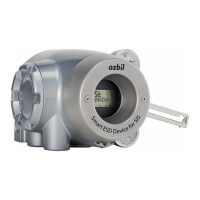2-19
3) Wiring procedure
The procedure for electrical wiring to operate the device is shown below.
Step Work
1
Loosen the locking bolts (M4) on the terminal box cover with a
hex wrench (3). (Rotate the screw clockwise.)
2
Rotate the terminal box cover counterclockwise to remove it.
Handling Precautions:
Be careful not to damage the paintwork with a tool or other
object.
3 Remove the dust-proof plug from the conduit connection port.
4
Insert the cable into the conduit connection port.
Handling Precautions:
Be careful not to damage the sheath of the cable.
5
Wire the cable to the relevant terminal in the terminal box.
Handling Precautions:
- Be careful of the polarity.
- Sufficiently tighten the terminal screw. The recommend
tightening torque is 1.5 N·m.
6
Apply sufficient waterproof treatment to the conduit to prevent
rainwater or other liquid from entering inside.
Handling Precautions:
We recommend using silicon non-hardening seal material.
7
Mount the terminal box cover, tighten it securely, and then
secure the cover by rotating the lock screw counterclockwise.
- Be careful not to get your finger caught in the clamp.
- Be careful not to hurt your finger with the edge of cover or
the screw threads of the main unit.
Handling Precautions:
Be careful not to damage the paintwork of the device with a
tool or other object.
Handling Precautions:
The input resistance for the AVP701/702 models must be the equivalent of 475 Ω
(600 Ω if equipped with overvoltage protection)/20 mA DC and the inter-terminal
voltage must be at least 9.5 V (12 V if equipped with overvoltage protection).
Check the controller's allowable load resistance and the output voltage. Note
that when the controller's allowable load resistance is less than 475 Ω (600 Ω
if equipped with overvoltage protection), an isolator or similar device should be
used.

